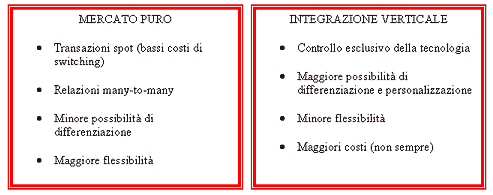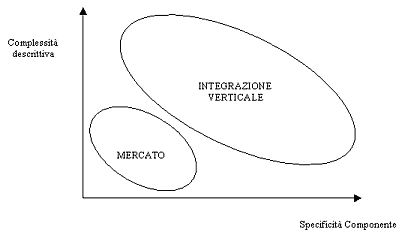
Figure 2: Two strategic alternatives 4
CHAPTER 1: MANAGEMENT OF SUPPLY CHAIN
1.4 Make or Buy? Two strategic alternatives
To the inside of the analyses of strategic character, still before that economic
(costs/benefits analyses), of creation of a durable and defensible competitive advantage, open for the corporate structure
two possible roads, the choice of which strongly are conditioned from the technological member.
On one side there is the solution of the specialization. The enterprise is concentrated in its Core business, that is
esternalizza and resorts market pure for all that series of connected activities but not re-entering in the typical activity
of the entrepreneur taken in consideration, and not decisive in the creation of value for the same company.
The enterprise is taken advantage therefore of a flexible slim organization and to the market turbulences, and is therefore
ready to face in more effective way the negative conjunctures.
Web ago sure the its part, facilitating the entrepreneur in
the actions of Market Intelligence, that is in those actions that carry to the finding of the best present conditions than
supplying on the market and that they allow the discouragement of the transaction costs.
Supplyings, of closely transaction nature, take advantage, in this case, the economies based on the acquired amounts, and in
any case they determine bottoms costs of switching from a supplier to the other.
However, the solution of the market resource
(Buy), also allowing upgrades approached them the innovation, it grants to the entrepreneur little space to the differentiation
possibilities, since putting into effect transactions spot, these it is based in decisive way on standard of market
(you see figure 2).
To the contrary, with the choices of Make (figure 2), is gone towards the vertical integration.
The enterprise adopts a more rigid and hierarchical organization, than but it allows them to benefit of one greater possibility
of differentiation and personalization of just prodotto/servizio.
The smaller flexibility therefore is accompanied from
greater costs (not in all the fields), had minor to the efficiency of the production process, that it represents most times the
higher price to pay.
Company takes advantage in this case, of control exclusive of technology, that he is congenital to the
type of activity that the enterprise carries out, through the software use on measure, to times also owners.

1.4.1 Descriptive complexity and specificity of the member to purchase
The descriptive complexity limits the convenience of the outsourcing from part of upgrades them customer, and is given from elements that increase the costs of transaction for the customer, in particular

|
Top| Summary| << Previous | Next >>
/en/home.php" TARGET="_blank">>> Home Page << |